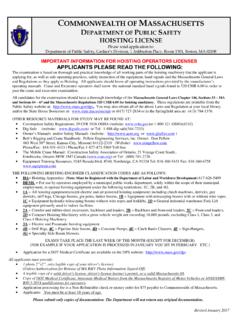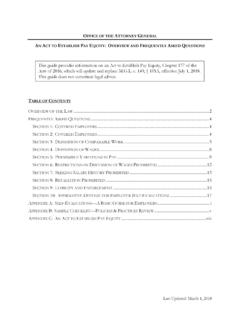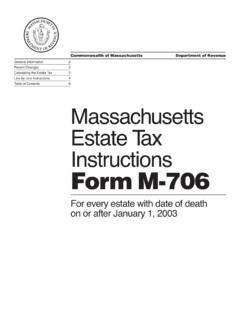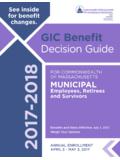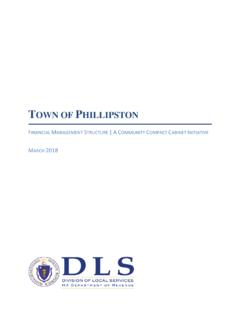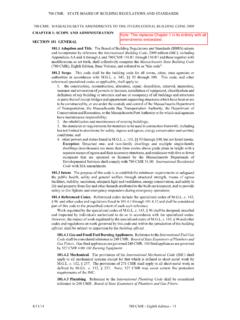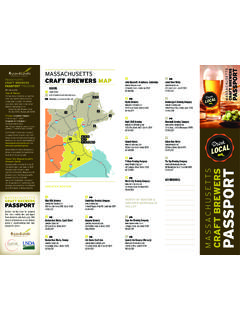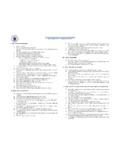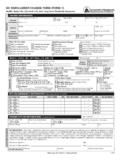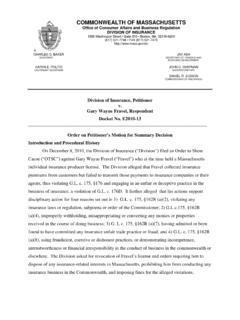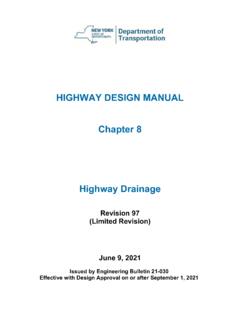Transcription of Enterprise Funds: A Best Practice Introduction
1 1 Enterprise Funds: A Best Practice Introduction Purpose This guide will help you understand: The definition of Enterprise Fund . Why Enterprise funds are important to your utility. How to implement Enterprise funds. Target Audience This guidance is intended for owners, managers, and operators of water, sewer, and stormwater systems, local officials , technical assistance providers and state personnel. The primary focus of this guidance is for massachusetts water, sewer and stormwater systems. Enterprise Funds An Enterprise fund is considered the best Practice to promote and maintain long-term financial sustainability for water, sewer and stormwater activities. An Enterprise fund is a separate accounting and financial reporting mechanism for which revenues and expenditures are segregated into a fund with financial statements separate from all other governmental activities.
2 An Enterprise fund identifies the total direct and indirect costs to provide the service and the sources and amounts of revenues that support the service for which a fee is charged in exchange for service. Direct costs generally consist of personnel services, expenses and capital outlay, which are budgeted and accounted for in the Enterprise fund. Indirect costs are expenditures budgeted and accounted for in the general fund on behalf of the Enterprise fund, which are allocated to the Enterprise fund for funding. Examples of indirect costs are central service department costs (accounting, treasury, collections, law and the like), insurances and fringe benefits that are not budgeted and accounted for in the Enterprise fund. Challenges faced by Utility Systems Benefits of Enterprise Funds Lack of timely and complete financial data. Rising cost to produce and treat water Decreasing revenues. Increasing pressure to conserve water.
3 Encouraging the efficient use of water. Depletion of groundwater. Degradation of water quality Aging infrastructure. Maintaining long-term financial sustainability. Identifies a total cost of service and related revenues for a service. Provides management information to analyze the extent to which revenues are covering expenditures. Retains and maintains investment income and surplus. Provides useful information to make decisions on user charges and other financing items. Provides the value of the Enterprise fixed assets and infrastructure and recognizes the cost of the annual depreciation of these assets. Provides long-term liabilities in the financial statements thus provides both short and long-term financial perspectives. 2 Implementing Enterprise Funds: The Core Framework The following framework should be followed to implement Enterprise funds. This framework includes: (1) Establishment of the Enterprise fund by the appropriating authority, (2) Establishment of the Enterprise fund budget, (3) Establishment of the Enterprise fund accounting system, (4) Analysis of current year revenues and expenditures, and (5) Establishment of the Enterprise fund reporting system.
4 Several Enterprise fund best practices are listed for each framework element. While allows for other general laws and special acts, Enterprise funds are considered to be the best Practice for water, sewer and stormwater activities. 1 Flow Chart: The Five Core Elements of Enterprise Funds 1 For example, Chapter 41, Section 69B allows for the establishment of a water (but not sewer or stormwater ) surplus account. Enterprise Funds 3. Accounting 2. Budget Warrant Article1. Acceptance 4. Analysis 5. Reporting 3 1. Enterprise Fund Acceptance The first step in establishing an Enterprise fund is for the appropriate government body to accept the provisions of Chapter 44, Section 53F .2 The Enterprise fund is established by vote of the city council with the approval of the mayor, by town council or by town meeting. Only massachusetts cities and towns may adopt an Enterprise fund pursuant to , 53F.
5 Best practices include: Adopting each Enterprise fund separately with its own vote. (Note that water and sewer may be combined; but the better Practice is to separate water and sewer into their own Enterprise fund). Using the following language: To see if the (city or town) will accept the provisions of Chapter 44, 53F of the massachusetts General Laws establishing (the service) as an Enterprise fund effective fiscal year (year). 3 Ensuring that the language of the vote clearly states what the service is and when the fund will commence which is recommended to begin at the start of a fiscal year. Ensuring that when converting from a special revenue fund to an Enterprise fund, the fund balance in the special revenue fund may be transferred to the fund balance of the Enterprise fund by vote of the legislative body. Any fund balance not so transferred must close to the general fund on June 30. Any fund balance transferred will become retained earnings only after certification.
6 2 See Exhibit 1. 3 For additional Enterprise fund guidance , refer to the Department of Revenue Enterprise Fund Manual, 4 2. Enterprise Fund Budgeting and Warrant Article The second step in establishing an Enterprise fund is to develop and have the appropriating body approve a budget. The budget is subject to the appropriation process. The community should: Determine the appropriate indirect costs incurred by the general fund on behalf of each Enterprise fund; do not charge the fund costs that are not truly associated with its purpose. Determine the direct Enterprise fund costs. Forecast revenues and expenditures for the upcoming fiscal year. Determine if any balances are to be brought forward from the general fund or a restricted fund. If so, the appropriating body must approve the transfer of the balance(s). Refer to language in Exhibit 2. Develop a balanced revenue and expenditure budget to include direct and indirect costs.
7 The Enterprise fund budget may be one of three scenarios in any fiscal year. o Estimated revenues (including any appropriations of Enterprise retained earnings) are equal to planned expenditures o Estimated revenues exceed planned expenditures where the surplus is budgeted as a reserve o Estimated revenues are less than planned expenditures where the difference is subsidized by the general fund or is otherwise provided by another fund. Submit to the local executive authority a proposed line item budget no later than one hundred and twenty days prior to the beginning of each fiscal year (March 1), in accordance with massachusetts General Best practices include: Developing an Enterprise fund budget that includes the direct costs of personal services, expenses, and capital outlay. Revising user charges prior to setting the tax rate. Identifying indirects costs for central services and other costs incurred by the general fund on behalf of the Enterprise fund(s) that are allocated to the Enterprise fund for funding.
8 Requesting an appropriation for direct Enterprise fund expenditures. Ensuring that indirect costs already included for appropriation in the General Fund operating budget are not to be included for appropriation in the Enterprise fund budget. Developing a revenue budget that provides for both the direct Enterprise fund budget and the indirect costs appropriated in the general fund on behalf of the Enterprise fund. Including appropriate reserves as part of the budget process, for more information please see Bureau of Accounts Informational Guideline Release (IGR) 08-101. Refer to Exhibits 2 - 4 for best Practice budget formats and language. 4 massachusetts General Law Chapter 44, Section 53 F . 5 3. Enterprise Fund Accounting The third step in establishing an Enterprise fund is to develop an accounting system. Once adopted, the process of establishing the Enterprise fund should begin using accounting records and identifying the assets (capital items and infrastructure), liabilities and equity.
9 Related funds in other restricted funds should be identified and transferred to the Enterprise fund if voted by the legislative body. You should work with the finance department to: Establish asset, liability, equity, revenues and expenditures accounts consistent with the Uniform massachusetts Accounting System (UMAS) chart of Ensure that revenues include user charges, utility liens added to taxes, connection fees, betterment assessments, miscellaneous fees, interest earnings, and other financing sources. Ensure that expenditures are known. Periodically reimburse the general fund during the year for indirect costs. Best practices include: Accounting for Enterprise funds on a cash basis. Accounting for related capital projects in the capital projects fund. Accounting for related fixed assets in the general fixed assets account group. Accounting for related long-term debt in the general long-term debt account group.
10 Establishing the budget warrant article to be consistent with Schedule A-2 of the Tax Recapitulation Sheet. Using budget control accounts to post the Enterprise fund revenues and other financing sources and expenditures and other financing uses budget consistent with Schedule A-2. Considering the establishment of a special purpose stabilization fund (See IGR 08-101) Establishing a separate interest bearing account for the Enterprise fund where interest on retained earnings and fund balances remain within the fund (or allocate the interest earnings that would be due on Enterprise fund balances and transfer that amount to the Enterprise fund on a periodic basis). 5 Uniform massachusetts Accounting System (UMAS) published by the massachusetts Department of Revenue, Bureau of Accounts. 6 4. Enterprise Fund Analysis The fourth step in establishing an Enterprise fund is to analyze the data provided to (a) monitor that actual revenue is on target to estimated revenue and (b) that your expenditures are on track to appropriations.
